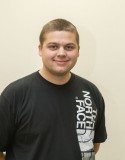Award-winning student helps complete planetarium conversion
After countless hours of labor by a dedicated student, the MHCC Planetarium’s new digital projection system is now ready to vividly display the visible and theoretical universe.
The digital system replaces an aging model that served since first few years of the Mt. Hood campus, said Ethan Ignatovich, a physics student with a fascination for astronomy.
“The old projection system keeps getting more dim, and students (were) having issues being able to pick out and see the stars in the dome,” Ignatovich said.
The new projection system consists of six digital projectors and lenses. Each projector is connected to a computer through a standard HDMI cable, Ignatovich said. The six computers interact and are linked to a seventh “master computer,” he said.
“This is the largest project I’ve ever worked on, it’s been interesting so far,” said Ignatovich who faced plenty of installation challenges. “For a while, there (was) something wrong with the configuration files and it would cause one of the computers to randomly crash.
Despite taking precautions, Ignatovich and the rest of the planetarium team fought frustration several times: “Just because the way the program is, there’s no save button, so every time they crash, we lose all the configuration files,” said Ignatovich.
The planetarium uses Microsoft’s Worldwide Telescope program, offered free to anyone. Jonathan Fay, a Microsoft employee and a friend of Pat Hanrahan, planetarium director, wrote the programming for Worldwide Telescope.
Hanrahan and Ignatovich spent about four full workdays getting the computers properly configured. For one of them, Fay volunteered to bring his own expertise to the project, Ignatovich said.
Troubleshooting programs is a joy for Ignatovich. “I like to go in and try to find where that problem is and fix it,” he said. “I’ve always had a curiosity about how programs work, so I’d often just open them up in some sort of configuration editor, just to see how they work, and maybe change a couple of things, see how they work differently.”
After he earns his physics transfer degree from Mt. Hood, he plans to attend Portland State University. “I’m gonna get an electrical engineering degree, probably work at Intel, or somewhere like that,” he said.
Physics and astronomy are closely related, he said. “I just find astronomy fascinating, just learning about all the different stars. It’s really interesting to see how amazing of an image you could get even from a little telescope.”
Ignatovich is awed both by astronomy’s colors and scope. “I mean, there’s some absolutely beautiful stuff in astronomy,” he said. “It’s interesting to think about how tiny of a fraction a person is in size compared to the size of the universe.”
He engaged in the planetarium project last winter, after Hanrahan mentioned the digital upgrade in one of the first astronomy courses he took. “I sort of talked him into letting me help out with it because I have a pretty good grasp on coding and stuff like that. I just stuck with it, and here we are.”
Ignatovich earned the Science Recognition Award for Winter term “for his outstanding service to the science division and the college,” said Brenda Wise, MHCC science lab coordinator.
“He has been a pleasure to work with during his time here. I will really miss Ethan when he graduates, but I know he will continue to excel at PSU,” she said.
Ignatovich credits simple perseverance.
“If there’s something that you think might be out of reach, like a program like this, or a project like this, just stick with it,” he advised other students.
“I never thought they’d let me get this involved with the program to actually be able to as much as I did. I would encourage everyone, if they think they have an interest in (something), definitely pursue it.”


Leave a comment